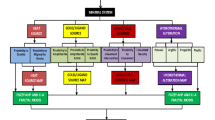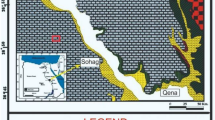Abstract
To address the issues for assessing and prospecting the replaceable resource of crisis mines, a geological ore-controlling field model and a mineralization distribution field model were proposed from the viewpoint of field analysis. By dint of solving the field models through transferring the continuous models into the discrete ones, the relationship between the geological ore-controlling effect field and the mineralization distribution field was analyzed, and the quantitative and located parameters were extracted for describing the geological factors controlling mineralization enrichment. The method was applied to the 3-dimensional localization and quantitative prediction for concealed ore bodies in the depths and margins of the Dachang mine in Guangxi, China, and the 3-dimensional distribution models of mineralization indexes and ore-controlling factors such as magmatic rocks, strata, faults, lithology and folds were built. With the methods of statistical analysis and the non-linear programming, the quantitative index set of the geological ore-controlling factors was obtained. In addition, the stereoscopic located and quantitative prediction models were set up by exploring the relationship between the mineralization indexes and the geological ore-controlling factors. So far, some concealed ore bodies with the resource volume of a medium-sized mineral deposit are found in the deep parts of the Dachang Mine by means of the deep prospecting drills following the prediction results, from which the effectiveness of the predication models and results is proved.
Similar content being viewed by others
References
LIU Liang-ming, PENG Sheng-lin. Key strategies for predictive exploration in mature environment: Model innovation, exploration technology optimization and information integration[J]. J Cent South Univ Technol, 2005, 12(2): 186–191.
PENG Sheng-lin, YANG Mu, LIU Liang-ming. Approaches to location prognosis of concealed ore deposits (bodies) of productive mines[J]. J Cent South Univ Technol, 2002, 9(2): 112–117.
BONHAM-CARTER G F, AGTERBERG F P, WRIGHT D F. Weights of evidence modelling: A new approach to mapping mineral potential[J]. Geological Survey of Canada, 1990, 89(9): 171–183.
AGTERBERG F P. Combining indicator patterns in weights of evidence modeling for resource evaluation[J]. Nonrenewable Resources, 1992, 1(1): 39–50.
SINGER D A. Basic concepts in three-part quantitative assessments of undiscovered mineral resources[J]. Nonrenewable Resources, 1993, 2(2): 69–81.
ZHAO Peng-da. Theories, principles, and methods for statistical prediction of mineral deposits[J]. Journal of Mathematical Geology, 1992, 24(6): 589–595.
WANG Shi-chen, CHEN Yong-liang, XIA Li-xian. Theory and method of mineral prediction using integrated information[M]. Beijing: Science Press, 2000: 65–180. (in Chinese)
ZHAO Peng-da. Three-component quantitative resource prediction and assessments: Theory and practice of digital mineral prospecting[J]. Earth Science — Journal of China University of Geosciences, 2002, 27(5): 482–489. (in Chinese)
XIAO Ke-yan, ZHU Yu-shen, SONG Guo-yao. GIS quantitative assessments of mineral resources[J]. Geology in China, 2000, 27(7): 29–32. (in Chinese)
HARRIS J R, WILKONSON L, GUNSKY E C. Effective use and interpretation of lithogeochemical data in regional mineral exploration programs: Application of Geographic Information Systems (GIS) technology[J]. Ore Geology Reviews, 2000, 16(3/4): 107–143.
ASADI H H, HALE M. A predictive GIS model for mapping potential gold & base metal mineralization in Takab area, Iran[J]. Computers & Geosciences, 2001, 27(8): 901–912.
CHEN Y. MRPM: Three visual basic programs for mineral resource potential mapping[J]. Computers & Geosciences, 2004, 30(7): 969–983.
HARRRIS J R, SANBORN-BARRIE M, PANAGAPKO D A, SKULSKI T, PARKER J R. Gold prospectivity maps of the Red Lake greenstone belt: Application of GIS technology[J]. Canadian Journal of Earth Sciences, 2006, 43(7): 865–893.
WANG Zhi-jing, CHENG Qiu-ming. GIS-based (W+-W−) weight of evidence model and its application to gold resources assessment in Abitibi, Canada[J]. Journal of China University of Geosciences, 2006, 17(1): 71–78.
LI Q, CHENG Q. VisualAnomaly: A GIS-based multifractal method for geochemical & geophysical anomaly separation in Walsh domain[J]. Computers & Geosciences, 2006, 32(5): 663–672.
YE Tian-zu, XIAO Ke-yan, YAN Guang-shen. Methodology of deposit modeling and mineral resource potential assessment using integrated geological information[J]. Earth Science Frontiers, 2007, 14(5): 11–19. (in Chinese)
ZHOU W, CHEN G, LI H, LUO H, HUANG S L. GIS application in mineral resource analysis-A case study of offshore marine placer gold at Nome, Alaska[J]. Computers & Geosciences, 2007, 33(6): 773–788.
FORD A, BLENKINSOP T G. Combining fractal analysis of mineral deposit clustering with weights of evidence to evaluate patterns of mineralization: Application to copper deposits of the Mount Isa Inlier, NW Queensland, Australia[J]. Ore Geology Reviews, 2008, 33(3/4): 435–450.
CASSARD D, BILLA M, LAMBERT A, PICOT J C, HUSSON Y, LASSERRE J L, DELOR C. Gold predictivity mapping in French Guiana using an expert-guided data-driven approach based on a regional-scale GIS[J]. Ore Geology Reviews, 2008, 34(3): 471–500.
CARRANZA E J M, RUITENBEEK F J A, HECKER C, MEIJDE M, MEER F D. Knowledge-guided data-driven evidential belief modeling of mineral prospectivity in Cabo de Gata, SE Spain[J]. International Journal of Applied Earth Observation and Geoinformation, 2008, 10(3): 374–387.
WANG Gong-wen, CHEN Jian-ping. Mineral resource prediction and assessment of copper multi-mineral deposit based on GIS technology in the north of Sanjiang Region, China[J]. Earth Science Frontiers, 2008, 15(4): 27–32. (in Chinese)
MAO Xian-cheng, DAI Ta-gen, ZOU Yan-hong, WU Xiang-bing. Research and system development of geological mineral database of the Dachang orefield[J]. Geology and Prospecting, 2003, 39(5): 72–76. (in Chinese)
ZOU Yan-hong, MAO Xian-cheng. Establishment and application of geological survey database[J]. J Cent South Univ: Science and Technology, 2004, 35(3): 463–467. (in Chinese)
CEN Kuang, YU Chong-wen. Mass and energy transport in ore forming processes of sulfide deposits in Tongling district[J]. Geochimica, 2001, 30(6): 533–539. (in Chinese)
ZHAO C B, PENG S L, LIU L M, HOBBS B E, ORD A. Effective loading algorithm associated with explicit dynamic relaxation method for simulating static problems[J]. J Cent South Univ Technol, 2009, 16(1):125–130.
Author information
Authors and Affiliations
Corresponding author
Additional information
Foundation item: Project(2007CB416608) supported by the National Basic Research Program of China; Project(2006BAB01B07) supported by the National Science and Technology Pillar Program during the 11th Five-Year Plan Period
Rights and permissions
About this article
Cite this article
Mao, Xc., Zou, Yh., Lu, Xq. et al. Quantitative analysis of geological ore-controlling factors and stereoscopic quantitative prediction of concealed ore bodies. J. Cent. South Univ. Technol. 16, 987–993 (2009). https://doi.org/10.1007/s11771-009-0164-6
Received:
Accepted:
Published:
Issue Date:
DOI: https://doi.org/10.1007/s11771-009-0164-6




